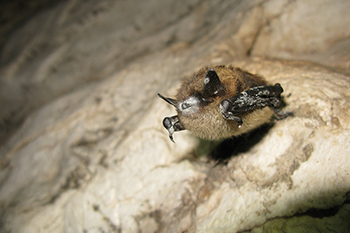
Bats in Riding Mountain National Park
Riding Mountain National Park
Bats are vital for a healthy environment. They are our primary nighttime insect predators and can eat up to half of their body weight in one night.
There are six species of bats found in the park. Two species are listed as ‘endangered’ under the Species at Risk Act. Hibernating bats include Little Brown Myotis, Big Brown Bat, and Northern Long-eared Myotis. Migratory bats include Eastern Red Bat, Hoary Bat, and Silber-haired Bat. Both the Little Brown and the Northern Long-Eared Myotis species are listed as ‘endangered’.
White-nose syndrome found in bats in Riding Mountain National Park

Four bats were tested and confirmed to have White-nose Syndrome this spring (2019). This syndrome is a fungal disease killing bats in North America. The cold loving disease eats into a bat’s wing tissue causing them to warm up and come out of hibernation too early to survive.
White-nose syndrome does not pose a threat to human health, however live or dead bats should not be handled as they do carry diseases and parasites harmful to people.
What can you do?
You can help bats! If you find a dead, sick or injured bat in the park please report the sighting to Parks Canada at 204-848-7264.
You can participate in the conservation of bats by reporting sightings. If you know of bats dwelling in a building, a bat house or a natural structure, visit the Neighborhood Bat Watch (https://batwatch.ca/) to report your sightings.
Bat research happening in the park
The park is taking a multi-research approach to better understand bats in Riding Mountain National Park.
Some research is confirming which species live here, as well, where they are spending their time or roosting, having and raising their young and overwintering.
Specific to White-nose Syndrome researchers are determining what bats need, how to protect them, the effects of the disease, how to help them survive the syndrome, and ways to stop it. The park also has two heated bat houses to compare how the bats use them differently and if they help bats survive white-nose syndrome. To date it seems these houses allow the bats to use less energy and therefore possibly increasing their survival rates.
Biologists are also capturing bats in the park. They swab for white-nose syndrome, take photos of the bats noses and wings for scar tissue (evidence of the disease), and then they attach passive integrated transponder (PIT) tags to the bats before they release them in order to try and determine where they overwinter. PIT tag readers are located at various cave entrances as well as on bat houses in the park. If tagged bats use these locations, the tag readers collect the data that the researchers then use to determine how the bats move around.
Across Canada we are rapidly losing millions of bats to white-nose syndrome, so protecting them from other threats is important.
As a leader in conservation, Parks Canada developed its own national bat monitoring protocol consistent with the North American Bat Monitoring Program (NABat) and is working closely with Environment Canada and other partners to ensure that our information will help inform larger conservation initiatives and the recovery of endangered bat species.
Parks Canada will continue to support bat populations through our research and monitoring efforts and protecting important bat habitat.
To find out how you can protect bats and White-nose Syndrome visit:
Parks Canada: Bats and Parks Canada
The Canadian Wildlife Health Cooperative: http://www.cwhc-rcsf.ca/wns.php
Find out more about species at risk
- Date modified :